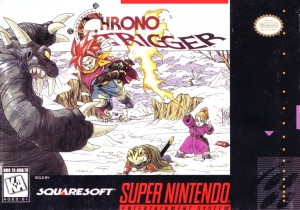In March of 1995, Japanese gamers were treated to the release of a new franchise from Square. Developed by a dream team including greats like Hironobu Sakaguchi, Yasunori Mitsuda, and Akira Toriyama, Chrono Trigger hit the ground running, winning plaudits and praise from every corner of the Japanese game industry. The first two million copies of the game were delivered to Japanese retailers in the first two months–at the time, a practically unheard-of sale rate for a JRPG. Across the seas in furthest America, people took notice. The swift localisation and August 1995 release of Chrono Trigger in North America was met with enormous success. Subsequent re-releases on the PlayStation and Nintendo DS were also very well received, posting chart-topping sales figures each in their turn. The PlayStation release of Chrono Trigger remains a best-selling PlayStation Network ‘Classic’ title more than a decade after its initial disc-based release, and several years into its digital availability.
In 2013, the success of Chrono Trigger is on par with other Super Nintendo-era greats such as Final Fantasy VI. Routinely featuring in historical “top ten” and “best of” lists, it came in second place (against Final Fantasy VII) in the first-ever GameFAQs “video game battle”, and it was last year named by GamesRadar as the greatest JRPG of all time. Re-released and ported to a variety of systems, it has continued to sell well despite its wide availability on the internet, having surpassed three and a half million copies sold. The DS version was one of the most well-received titles for that system–a remake which is still held up as an example of precisely how to correctly re-release classic 16-bit JRPGs.
The game opens with the titular protagonist, Chrono, waking up in his hometown in the Kingdom of Guardia. The year is A.D. 1000 and a Millennial Fair is about to take place. Chrono’s friend Lucca–an inventor–has built a matter transporter with the assistance of her father, Taban. It is this device which sets events into motion. Chrono’s fortuitous meeting with a young woman named Marle is the catalyst for an adventure which will span not merely the breadth of the world, but the very length of time itself.
All areas of Chrono Triggers‘s presentation have been praised since its release nearly a score of years ago. The music is widely considered to be one of the greatest soundtracks ever written for a video game. The graphics represent the pinnacle of sprite-based design; the DS version especially is renowned for its beautiful presentation, including the anime cut scenes from the PlayStation version, and an updated interface which makes use of the second DS screen for menus, freeing the top screen to display an unfettered view of Chrono Trigger’s colourful and detailed environments.
Use the comment thread below to discuss your approach to the game, challenges you have faced, tactics you are employing, and what you are getting out of your playthrough. Do you feel that the presentation of Chrono Trigger has held up since its release in 1995? Are there aspects of the game that you would change, or that you would hold up as an example for modern game developers to emulate? How has your experience with other RPGs released after Chrono Trigger changed your impressions of the game? Do you have any stories about your first experience? Tell us in the comments!
The aim in this playthrough is to complete the entirety of the game in four weeks. For our fourth and final week, we invite users to finish the game. However, feel free to join in, even if you are behind on the playthrough. Anyone and everyone is invited to participate, regardless of game format, speed of play, or familiarity with the series. Tell your friends!
Without further adieu, it is our very great pleasure to invite you now to join the Lusipurr.com staff members, guests, and readers as we return to the sunny days of the Guardia Millennial Fair in Peaceful Days: A Chrono Trigger Playthrough!



